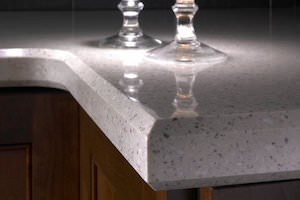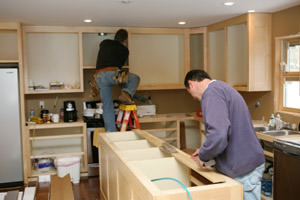Fitting the worktop
Fitting a straight run of worktop is reasonably straightforward. However, joining a two lengths to take a worktop a round corner requires more care, as the join needs to be perfect to create a continuous, flat finish. Corner joint steps are tipple to use, but don not provide the best finish. Better joins can be achieved if you let us use our worktop joining techniques provided by our professional worktop fitters.
Cutting a worktop length (laminate worktops, earthstone worktops or synthetic stone worktops and real wood worktops)
For a straight run, we cut the worktop to the right length, including an overhang of about 25mm (1 inch) at each end.
Joining a worktop
If the worktop has to turn to a corner, it is necessary to join two lengths. At this moment, options to joining worktops are limited by the material the worktop is made from, and whether its profile is square or rounded. The best technique and the most we use to join two lengths is the biscuit joint.
Securing a worktop
Once the worktop has been fitted, it will be secured in place using screws inserted through the worktop fixing brackets that are attached to the units and fixing wail.
Finishing Worktops
Laminated worktops
These often have unfinished edges that require covering with laminate strips supplied by the manufacturer. The strips can sometimes be ironed on, but others, will need contact adhesive. Once the strip is fixed in place and any adhesive is dry, the edges are trimmed flush using a craft knife.
Synthetic stone worktops
Sawn edges of some types of synthetic stone can be sanded smooth.
Solid wood worktops
These are the best sanded smooth, then stain-protected using the oil recommended by the worktop manufacturer. The surfaces has to be painted with several coats of oil, removing any excess with a dry cloth. Sometimes, extra oil may be required at intervals to maintain the finish.



